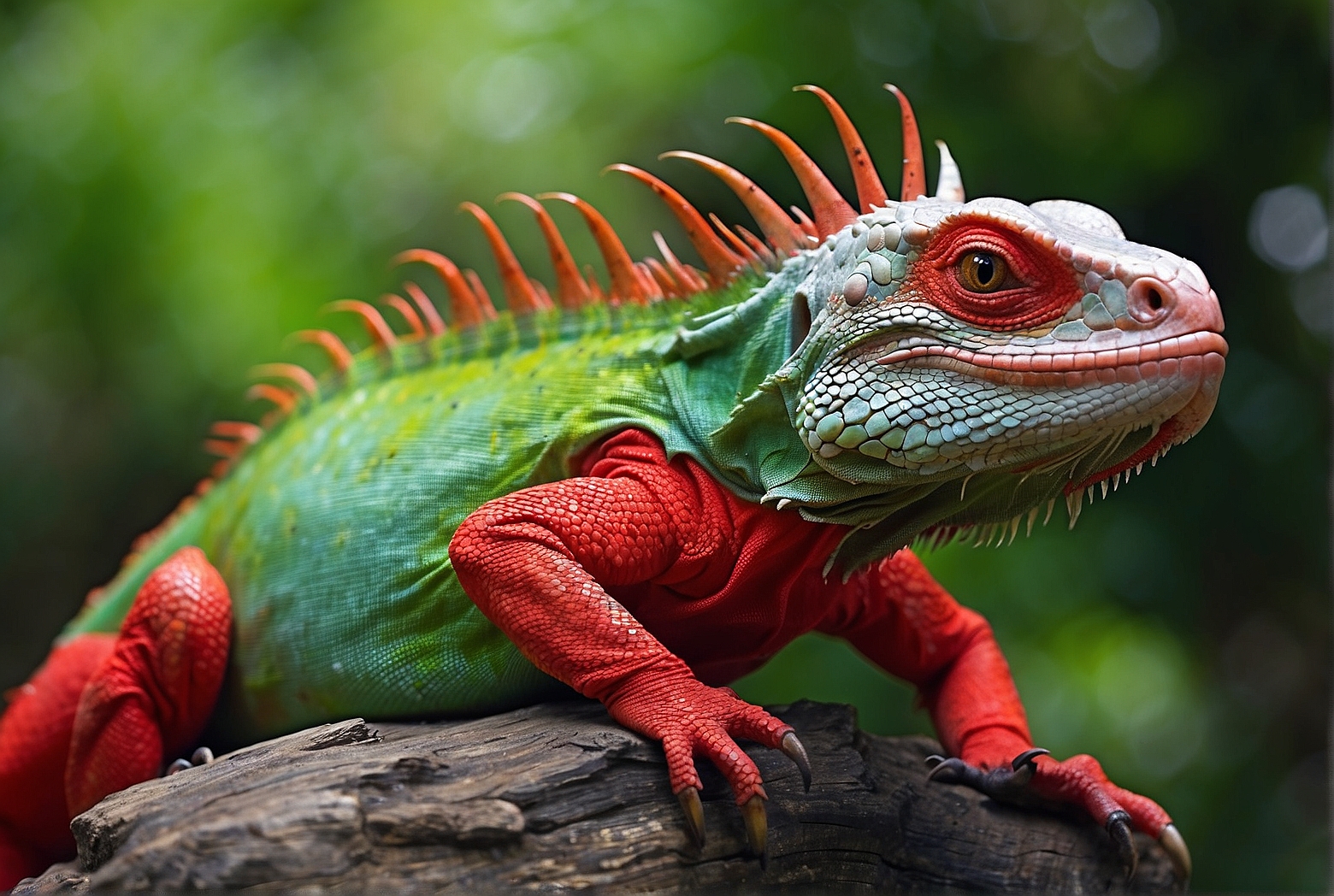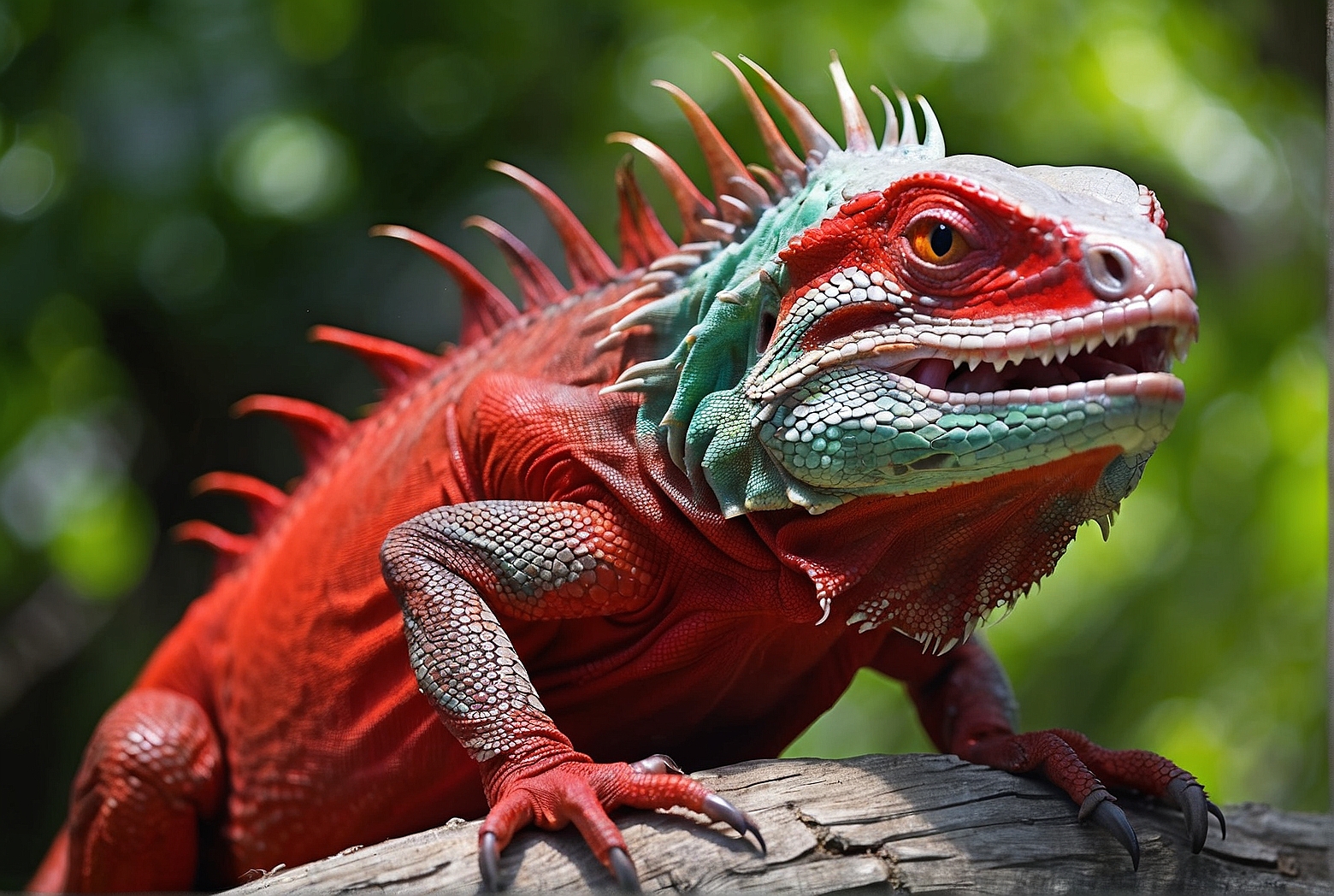Have you ever wondered about the differences between red and green iguanas? In this article, we will explore and understand the distinct characteristics that set these two species of iguanas apart. From their physical appearance to their behavior and habitat preferences, we will take a friendly journey into the fascinating world of red and green iguanas and uncover the unique traits that make each one so special. So, let’s dive in and discover the distinctions between these colorful reptiles!
Physical Appearance
Size
Red and green iguanas primarily differ in size, with red iguanas generally being larger than their green counterparts. Adult red iguanas can reach impressive lengths of up to six feet, including their tail, whereas green iguanas typically reach about four and a half feet. Keep in mind that these measurements are approximations and can vary depending on the individual.
Coloration
The most noticeable distinction between red and green iguanas lies in their coloration, as their names suggest. Red iguanas have a striking reddish-brown color, often accompanied by darker patterns or spots. On the other hand, green iguanas boast a vibrant green hue and may display subtle variations in shades across their body. It’s important to note that while these are the most common color patterns, both species can exhibit some degree of color variation.
Body Shape
While red and green iguanas share a general body structure, there are slight variations in their physique. Red iguanas tend to have a stockier build, with a larger head and more muscular limbs. In contrast, green iguanas have a leaner appearance, with a slightly longer and more slender body. However, it’s essential to remember that individual variations exist within each species.
Habitat
Native Range
Red and green iguanas differ in their native ranges. Red iguanas are primarily found in Central and South America, including countries like Mexico, Venezuela, and Brazil. On the other hand, green iguanas originate from the tropical regions of Central and South America, including areas such as Mexico, Brazil, and the Caribbean Islands.
Preferred Environments
Habitat preferences also vary between red and green iguanas. Red iguanas thrive in arid and semi-arid regions, such as dry forests and coastal areas. These habitats offer them the right balance of sunlight and shelter. Green iguanas, on the other hand, prefer more humid environments like rainforests and savannas, where they can find ample vegetation and moisture.

Territorial Behavior
Both red and green iguanas exhibit territorial behavior to some extent. Red iguanas tend to have a more aggressive territorial nature, defending their chosen areas vigorously. They may display dominance behaviors, such as head bobbing, tail lashing, and even chasing intruders. Green iguanas are also territorial but are generally less confrontational, often resorting to visual displays rather than direct confrontation.
Diet
Herbivorous Diet
Both red and green iguanas have a herbivorous diet, meaning they primarily feed on plant matter. Their digestive systems are specifically adapted to process fibrous vegetation efficiently. Although they share this dietary preference, the specific food sources they munch on may differ slightly.
Preferred Food Sources
Red iguanas are fond of consuming broadleaf plants, flowers, fruits, and even certain cactus species. They can be more inclined towards wildflowers and leafy greens. On the other hand, green iguanas often show a preference for consuming leafy vegetation, such as various tree leaves, flowers, and fruits. They may also consume some plant matter that red iguanas do, but their diet primarily consists of more leafy greens.
Feeding Habits
Both red and green iguanas are diurnal, meaning they are active during the daytime, which is when they actively seek out their food. It is crucial for these iguanas to maintain a balanced diet to meet their nutritional needs. Providing a variety of fresh vegetables, fruits, and leafy greens, along with occasional treats like hibiscus flowers or prickly pear cactus pads, can help ensure their dietary requirements are met.
Reproduction
Mating Behavior
During the breeding season, both red and green iguanas showcase distinct mating behaviors. Male iguanas may become more territorial and exhibit aggressive displays to assert dominance and attract females. They may bob their heads, extend their dewlaps (skin under the chin), and engage in ritualized fights with other males to compete for mating opportunities. Female iguanas demonstrate receptive behaviors, such as head-nodding and physical proximity to the males they find suitable.
Egg-laying Process
After successful mating, female iguanas proceed to lay eggs in carefully chosen locations. Both red and green iguanas are oviparous, meaning they lay eggs rather than giving birth to live young. The females dig nests in suitable soil or sand, deposit their eggs, cover them, and let them incubate.

Incubation Period
The incubation period for iguana eggs depends on various factors, including temperature and species. In general, iguana eggs take around 60-85 days to hatch. Temperature plays a vital role in determining the offspring’s sex, with higher temperatures resulting in more females and lower temperatures favoring males.
Behavioral Characteristics
Aggression Levels
Red iguanas tend to exhibit higher aggression levels compared to green iguanas. While both species can become territorial and display aggressive behaviors, red iguanas are more likely to defend their territory fiercely and confront intruders. Green iguanas, although territorial, may resort to visual displays and only engage in direct confrontation as a last resort.
Activity Patterns
Both red and green iguanas are diurnal creatures, meaning they are active during the day and rest at night. During the day, they engage in various activities like basking in the sun to regulate their body temperature, foraging for food, and socializing within their communities. However, they may also display different activity patterns depending on their specific habitats and environmental conditions.
Social Interactions
While iguanas are generally solitary animals, they do exhibit some social behaviors. Hatchling iguanas may stay in small groups for protection, but as they grow, they become more independent and often prefer a solitary lifestyle. However, during the breeding season, both red and green iguanas come together to mate. These brief social interactions play a crucial role in their reproductive cycle.
Lifespan
Expected Lifespan
Red and green iguanas have similar expected lifespans when kept in suitable environments and provided with proper care. On average, they can live for 10 to 15 years, with some individuals even reaching 20 years or more. Optimal nutrition, habitat conditions, and stress-free environments can contribute to maximizing their lifespan.
Factors Influencing Lifespan
Several factors can influence the lifespan of red and green iguanas. Adequate nutrition, including a balanced diet rich in essential nutrients, plays a pivotal role in their overall health and longevity. Optimal environmental conditions, such as maintaining the appropriate temperature, humidity, and access to basking spots, are crucial for their well-being. Regular veterinary check-ups and minimizing stress also contribute to extended lifespans.
Conservation Status
Population Status
The conservation status of red and green iguanas varies. Red iguanas, particularly some subspecies, may face significant population declines and are classified as endangered or critically endangered. Factors such as habitat loss, illegal hunting for their meat or skin, and capture for the pet trade contribute to their threatened status. Green iguanas, while not currently endangered, face similar threats due to habitat destruction and unsustainable collection for the exotic pet trade.
Threats and Challenges
Both red and green iguanas encounter several threats and challenges to their survival. Habitat loss and fragmentation are significant concerns as human activities continue to encroach upon their native habitats. Illegal hunting and poaching, driven by the demand for their meat, skin, or as pets, pose significant risks to their populations. Climate change and the associated habitat alterations also impact these reptiles, disrupting their natural behaviors and reproductive patterns.
Legal Protection
International Trade Restrictions
Red and green iguanas are protected under various international agreements and legislations to regulate their trade and prevent unsustainable exploitation. The Convention on International Trade in Endangered Species of Wild Fauna and Flora (CITES) lists certain subspecies of red iguanas and, in some cases, green iguanas, under Appendix I or II, which imposes restrictions on their international trade to ensure their long-term survival.
Domestic Ownership Regulations
In many countries, including the United States, ownership and trade of red and green iguanas are subject to specific regulations to prevent illegal activities and ensure the welfare of these animals. Prospective owners may need to obtain proper permits or licenses, adhere to certain enclosure requirements, and demonstrate appropriate knowledge and commitment to their care before being allowed to keep these reptiles as pets.
Popular as Pets
Suitability as Pets
Both red and green iguanas can make fascinating pets for the right individuals who are willing to provide the necessary care. However, their suitability as pets depends on various factors. They require spacious enclosures, with appropriate lighting, heating, and humidity levels replicating their natural habitat. Additionally, they need a varied, nutritious diet, regular veterinary care, and mental stimulation to thrive.
Care Requirements
Owning a red or green iguana requires a significant commitment to their care. Ensuring a large and secure enclosure with proper heating and lighting is crucial. They need a rich diet consisting of leafy greens, fruits, vegetables, and occasional supplements. Regular check-ups with a reptile veterinarian, monitoring their environmental conditions, and providing opportunities for exercise and mental stimulation are all essential aspects of their care.
Challenges of Ownership
Potential owners should be aware of the challenges associated with owning red or green iguanas. Their size and specific care requirements demand a dedicated and knowledgeable caregiver. Iguanas can exhibit territorial behaviors and potentially become aggressive if not properly socialized or handled. Their long lifespan also requires a long-term commitment, making them unsuitable for individuals seeking short-term companionship.
Misidentifications
Common Confusions
Red and green iguanas may be confused with each other, as well as with other similar-looking reptiles. Young green iguanas sometimes display reddish hues, leading to misidentification as red iguanas. Furthermore, the presence of color variations and hybrids between the two species can further complicate identification. Careful observation of physical characteristics, including size, coloration, and body shape, as well as knowledge of their specific habitat ranges, is necessary for accurate identification.
Distinctive Features
Despite the potential for confusion, red and green iguanas possess some distinctive features that can aid in proper identification. Red iguanas typically have a more robust body structure, larger head, and their overall reddish-brown coloration sets them apart. Green iguanas, on the other hand, exhibit a leaner physique, with a vibrant green coloration. Familiarizing oneself with these key differences can facilitate correct identification and prevent misattributions.
